Text
Soy milk mordant. Useful for treating cellulose fibres to work with protein dyes.
Washing my fibres in the washing machine with washing soda. (Say washing again. Washing)
Using a 1:5 ratio of soy milk to water in my dye pot
Putting the wet pieces straight from the machine in to the soy milk bath
Leaving 12 hours or overnight
Wringing the cloth out or spinning in the washing machine
Letting dry in the sun
Wetting again in the soy milk bath and letting dry x 2
Store for at least a week before dying
1 note
·
View note
Text
Foraged wild fennel dye


Skeins as they were drying and I was already so excited about how they were turning out
In autumn, I took myself picking in the definitely haunted abandoned orchid behind the railway, between the housing estate and the wetlands. There were signs of at least one person living in the bushes there, and I hoped that I wasn't about to surprise anyone/make them feel uncomfortable. I helped myself to blackberries, and stripped the wild growing fennel of all the feathery leaves I could find. (Fennel is invasive in my part of the world.) The plants in the orchid were tall after a wet summer, going to seed. In the way of annuals going to seed, there weren't many leaves left, but plenty for my first experiment with fennel.
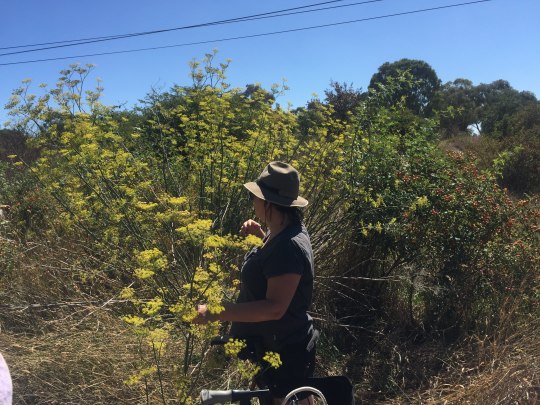
Pictured: my dear friend with a giant fennel plant. This friend first showed me the abandoned orchid.
I try to do 1:1 leaves to weight of fibre in all my dye baths, but I'm not precise about it.
The dyebath of fennel leaves I heated and let cool over several days. The smell was the most potion of potions I have ever. Aniseed but turned up to 11.
I mordanted my fibre with alum before adding it to the dyebath
After heating and cooling to extract the colour, I strained out the leaves and added the alum mordanted fibre. Gently heated and held at 80c for as long as I could be bothered (an hour).
(Note to self for next time: try flowers as well as leaves.)
Modified with iron water - warm water and {iron water preparation} left in bucket for 1 hour. This shifts the tone from a yellowish green down to a forest green <3


So I can never seem to get a good photo, it is much much greener in real life I swear
5 notes
·
View notes
Text
Indigo dress
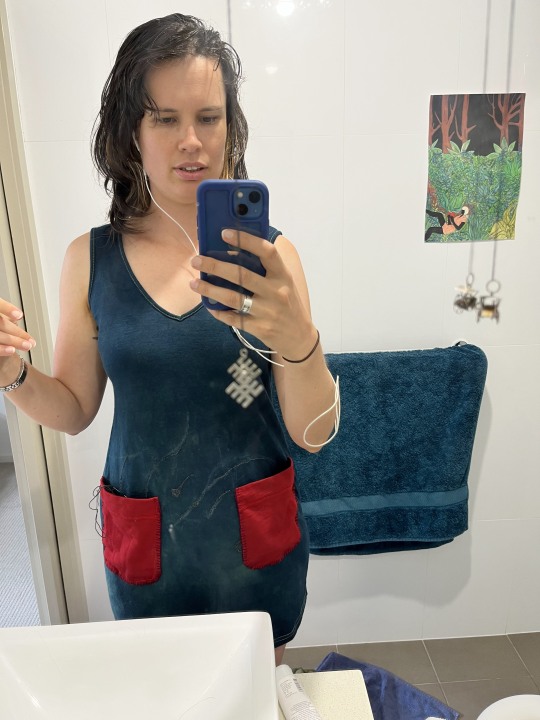
Indigo dress was salvaged from someone's cast-offs as it had moth holes. I dyed it with indigo from a disappointing avocado green, then sewed on pockets and did some visible mending over the moth holes.
1 note
·
View note
Text


St John's Wort is a weed which grows in abundance where I live in SE Aust. I used an alum mordant on sock wool (wool+nylon) and got a delicious green!
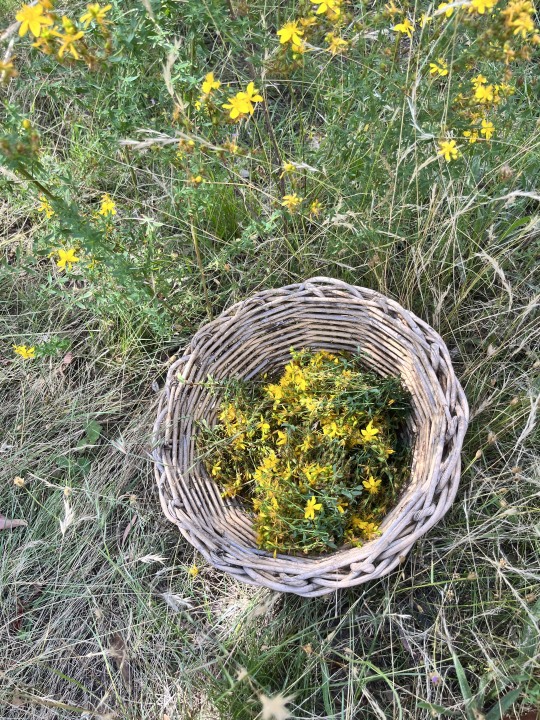
Gathering the st john's wort flowers
I did this dye experiment out in the bush using dam water and a fire as my heat source.

Mordanting the wool with 20% weight of fibre alum at 80C for 20 minutes
I gathered enough st john's wort flowers to fill my dyepot, covered it with dam water and boiled it for about an hour, strained out the dyestuff allowed it to cool and added the fibre, simmered for a further hour.


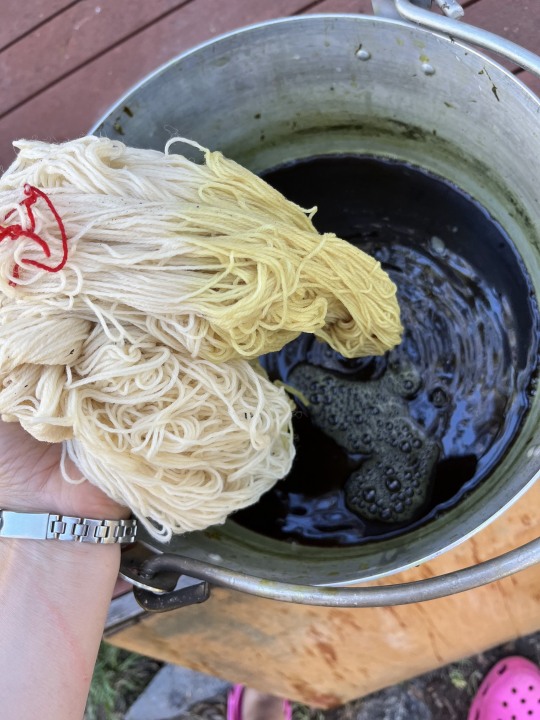
Dipping the wool into the dyebath and observing the colour take up.

The onions weren't part of the dye process, they were for dinner.
I then allowed the whole dyebath to cool down before rinsing out the wool. To speed up the cooling processes I put the whole pot in the dam.


My phone makes the result look quite yellow, but it's actually a light green.
If I try this again, I'd like to extract the dye over a couple of days of reheating the pot and allowing it to cool before straining out the st john's wort and adding the wool. Would also like to try tone shifting with iron water after i take it out of the dye pot
1 note
·
View note
Text
Socks!




Finished socks from the nylon-merino blend dyed with E. melidora
Still perfecting my sock technique, but very happy with how these turned out.
7 notes
·
View notes
Text
Indigofera australis dye plans
-pick indigofera leaves early one day in the cool, treat gently and protect from bruising. use lots of leaves
-try another solar method in glass jar with warm water and salt
-try a fermentation vat, need to get wheat bran and rice/corn syrup and ph test strips
useful resources: http://fibershed.org/wp-content/uploads/2018/08/production-of-Indigo-dye-aug2018-update.pdf for researched rundown of the process and chemical reactions
http://www.ecotonethreads.com/wp-content/uploads/2015/08/IndigoDyeRecipeSmall-File.pdf for indigo fermentation step by step
https://blog.ellistextiles.com/2020/01/30/indigo-still-learning-and-at-last-indigo-fermentation/ for a different fermentation approach
0 notes
Text
Indigofera australis Experiments pt. 3
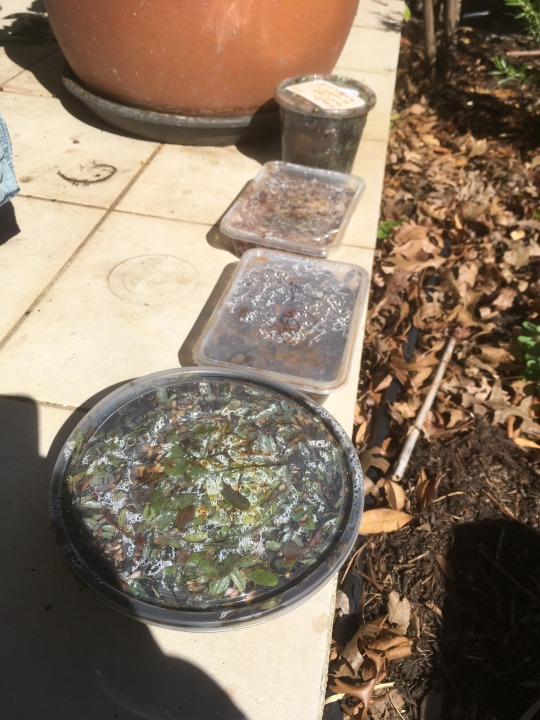







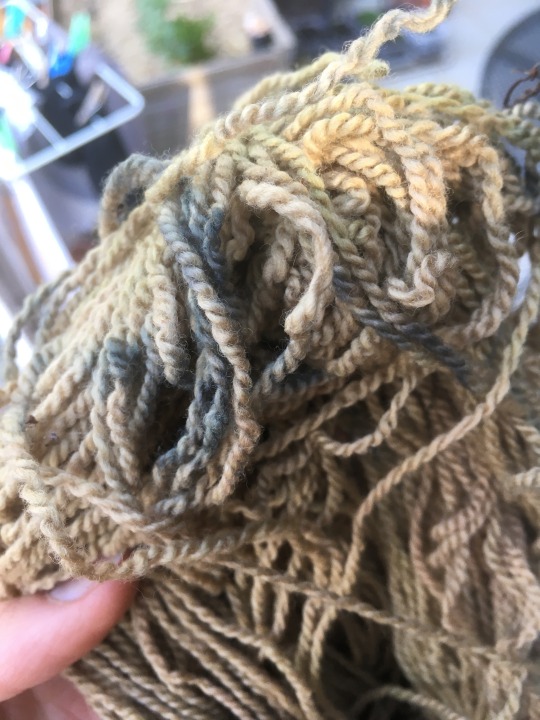
The remainder of indigofera experiments are solar dyes that have left in the sun for two weeks
I wrote the method on each of the containers, but the rain washed it off, so trusting to my untrustworthy memory here!
Vaguely following the instructions on Turkey Red Journal
large round containers: leaves + water soar dye
The fibres were one skein of Millpost merino, and one skein of and nylon blend with alum mordant and a faint E. pauciflora overdye.
These two were the most exciting results, there was a little bit of blue on each of them that developed on the strands that were at the top of each container. Blue! My theory is that indigo needs oxygen to bond with fibre, and maybe the blue only at the top because that's where the water level was? Keen to try again with a solar dye that's half full of water and regularly agitated.
Takeaway containers
One is indigofera leaves plus white wine and the other is indigofera flowers in wine. Neither of these worked at all, and the results smelled horrible!
4 notes
·
View notes
Text
Indigofera australis Experiments pt. 2
After the unsuccessful smoothie method outlined in previous post, I tried the 'direct method' from Turkey Red Journal:
"Chop small branches and leaves and put them into a glass container, fill with water to the very top and seal with an air tight lid. Leave to soak for 48 hours in a warm sunny position.
Strain carefully, removing all the foliage, trying not to introduce any oxygen. Carefully return the liquid to the jar. Put it in a warm sunny position and introduce skein which has been pre-wetted. Leave the skein in the liquid for 20 minutes.
Remove the skein carefully, again trying not to introduce any oxygen. Hang it exposed to the air for 20 minutes, by which time it should have turned a pale blue.
Repeat the above procedure until the shade of blue required has been achieved or there is no further colour change."
I used the dyebath and previously strained leaves from the unsuccessful smoothie attempt, leaving out in the sun for approx 72 hours.
Again, there was no characteristic colour change upon contact with oxygen, and my theory is that there is not enough indican present to create the desired effect. The colour is pale brown bordering on yellow, and I'm interested to see if i can get a green in future.
Next time i want to try this process with leaves picked after a low rainfall period, and use a high ratio of leaves to fibre.

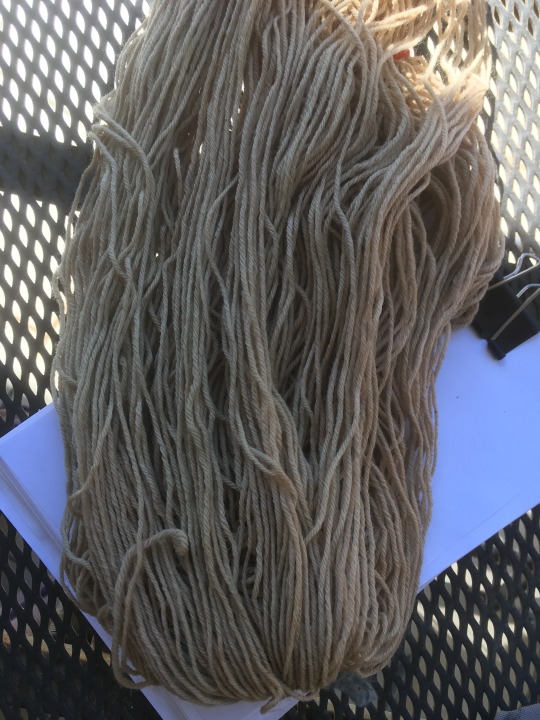
1 note
·
View note
Text
Indigofera australis Experiments pt. 1




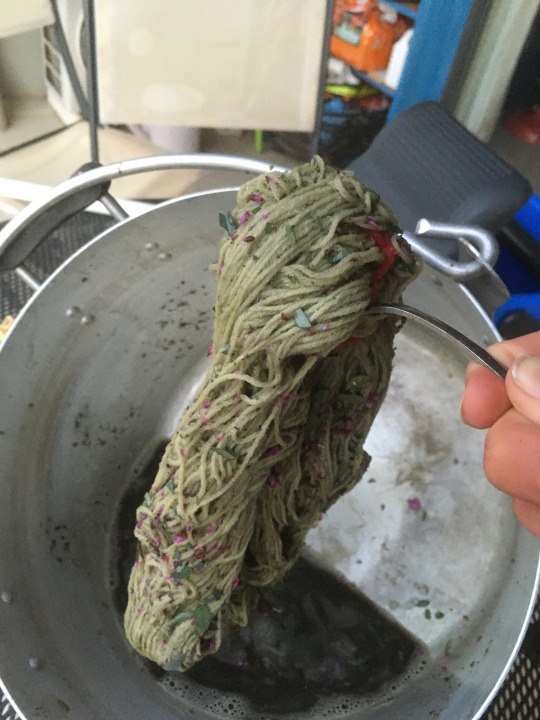
Collected Indigofera australis (austral indigo) with E from ANU campus on 26th September 2021. SE Australia is in a wet rainy cycle at the moment, so many big prolific bushes in flower!
My first time using I. australis, I decided to experiment with the leaves several different ways.
Modern dye techniques often use a very alkaline dyebath for indigo, which is toxic and cannot be disposed of via domestic sewerage. In my textile practice I wish to pursue low impact methods, meaning that I want to find an alternative to the high alkaline conventional method (even though the results were stunning and a lot of fun). The next few posts will document the results of these different experiments.
I. australis contains indigotin, the same blue molecule as other Indigofera plant species from Europe and Asia, so it follows that techniques developed for other species of Indigofera might work with I. australis. I read this very useful blog documenting one dyer’s experiments using I. australis using a Japanese ‘direct’ method: https://www.gumnutmagic.com/dyeing-with-australian-indigo/
They were following the method documented here: https://www.thedogwooddyer.com/blog/2019/8/25/fresh-leaf-indigo-experiments-at-john-marshalls-studio
https://www.thedogwooddyer.com/blog/2014/9/27/fresh-leaf-indigo-dyeing
These blogs said it’s best to use the plants on the same day that they’re picked, so I rushed to complete the process before dinner! I made a delicious smoothie out of indigofera leaves, using iced water to keep things cold. I strained the leaf bits out and dipped a skein in it for a couple of minutes before exposing to air, repeating the process several times. As I understand it, the indigotin molecule needs to be exposed to oxygen to bond with fibre, so a process of dipping in a dye vat and exposing to air made sense to me.
Nothing much happened. There was no telltale colour change when the fibre was exposed to oxygen. The greenish result in the final picture washed out immediately. I’ve got several theories about this – next time i will pick the indigofera in the early morning after a period of low rainfall, and use a very high ratio of indigo leaves to fibre, at least 2:1.
I really hope I can get this process working, because it is so simple and low impact. I love that it doesn’t involve heat or amendments of any kind.
0 notes
Text
Results from Traditional Indigo Dyebath

powdered indigo, sodium carbonate (washing soda), and sodium hydrosulphite
darker fabric = overdye on avocado green woollen dress
lighter fabric = cream silk shirt
2 notes
·
View notes
Text


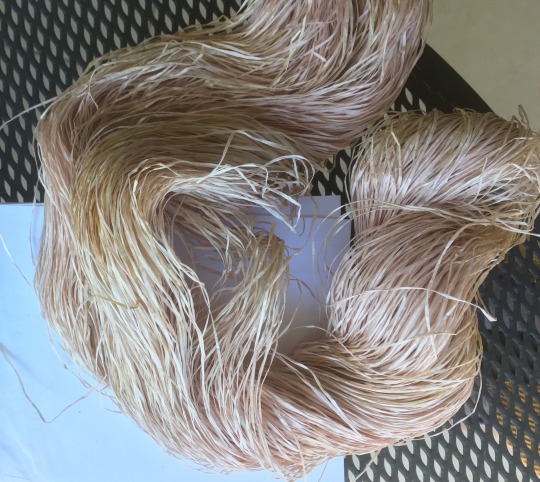
First attempt at solar dye
Red camellia petals packed into jar and topped up with water.
-left in sun for ~4 weeks
-hot microwave extraction with vinegar onto hemp raffia.
-layered petals and fibre in microwave safe container, poured over dye liquor and topped up with white vinegar. microwaved for 15 mins and allowed to cool completely before removing from dyebath and set out to dry
-produced rather ordinary pale pink
2 notes
·
View notes
Text

E. melliodora – yellow box on alum-mordanted wool
-dark orange skeins: nylon-merino blend
-light orange: pure merino from millpost merino
-eucalyptus leaves harvested may 2021 from trees on lawson crescent, acton
1 note
·
View note
Text
Secondary dyepot with E. pauciflora

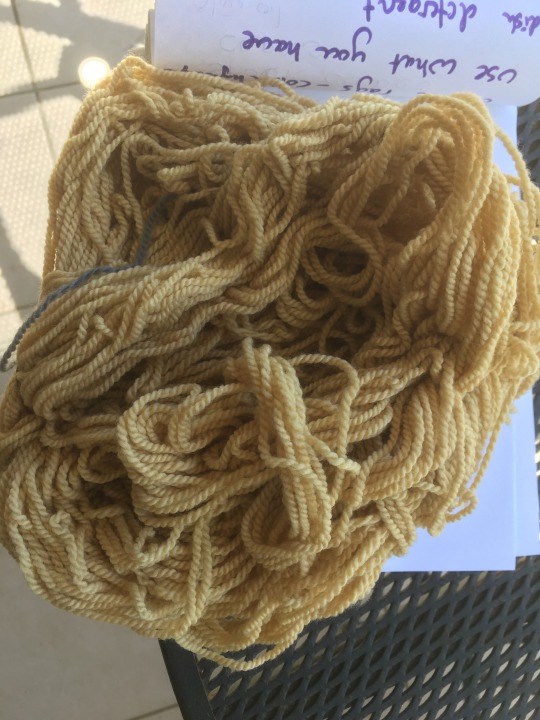
So happy was I, with the colour of the socks in my first experiment with E. pauciflora that I decided to give the dyepot another go and topped it up with more Eucalyptus pauciflora leaves.
I'm mindful of my impact when gathering leaves to use as dyestuffs. snowgums are a rare-ish tree in Canberra, especially in natural settings. Therefore I only gather fallen leaves occasionally from wild trees, or harvest sparingly from cultivated trees. There are many different subspecies of E. pauciflora, and this will probably influence the outcome of the dyepot.
For the 2nd dyepot I topped it up with E. pauciflora from cultivated saplings growing at Lennox crossing sculpture park and boiled these leaves in dyepot with added water for 2-3 hours.
The result was pale lemon colour. I tried to dye maybe 5 skeins of wool – I think too much fibre for the available pigment. It produced a buttery lemon on pure merino and brown on merino nylon blend (forgot to take photos of the nylon blend before overdying). Undecided if I will use this light yellow merino skein or overdye it. I've used the nylon blends in my austral indigo experiments.
-
Around this time I discovered that I’ve been inadvertently shrinking my wool in the dyepot from accidentality boiling it – I’m a bit laissez-faire about letting the dyepot heat up unsupervised, and the old tea urn that we use is no good at holding temp below boiling, so can’t be left alone for long periods of time.
1 note
·
View note
Text
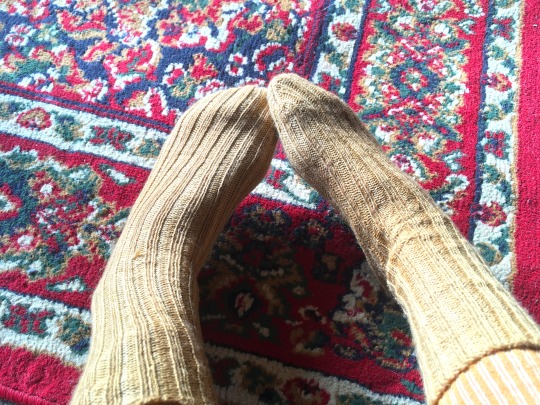


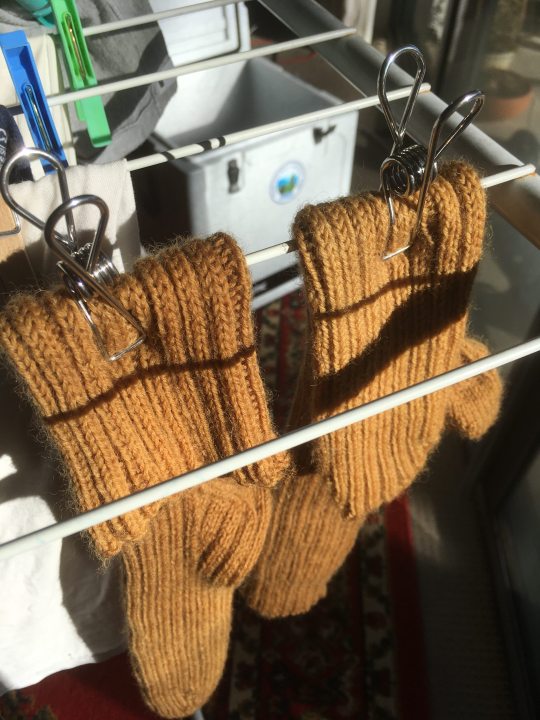
Dying with snow gum, E. pauciflora
-white hand knitted socks – merino nylon blend patonyle sockwool
-E. pauciflora leaves collected from dead and windfall leaves Mount Ainslie July 2021
-mordanted with alum potassium alum sulphate prior to dying, adding 12-20% alum per weight of fibre to water and gently heating to 80*c for 45 minutes.
-covered leaves in water, boiled in dyepot for 2-3 hours. left for one week until I had time to complete the process.
-removed some leaves from dyepot, added fibre, maintained heat below boiling for ~2 hours. Allowed fibre to cool in dyepot overnight.
-smooth shiny gold appearance, very happy with colour and with successful use of dead leaves. Needed a high volume of snowgum leaves to produce this effect.
0 notes
